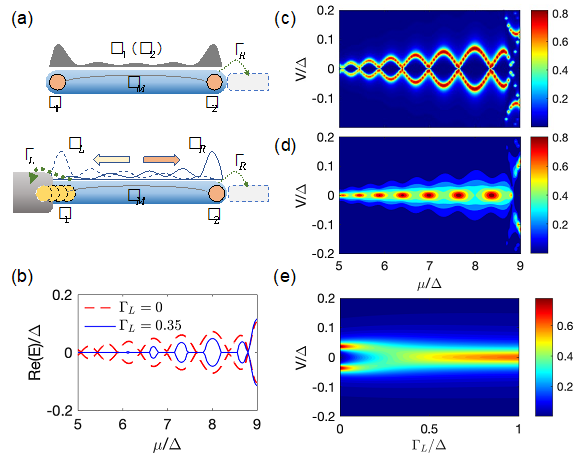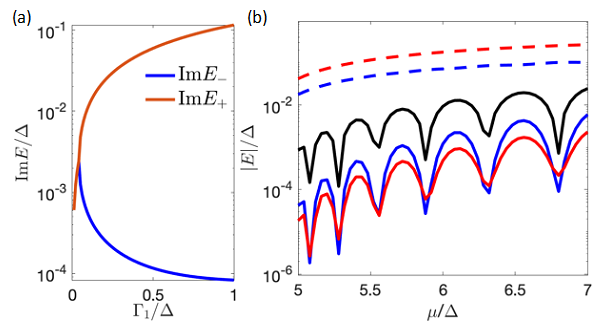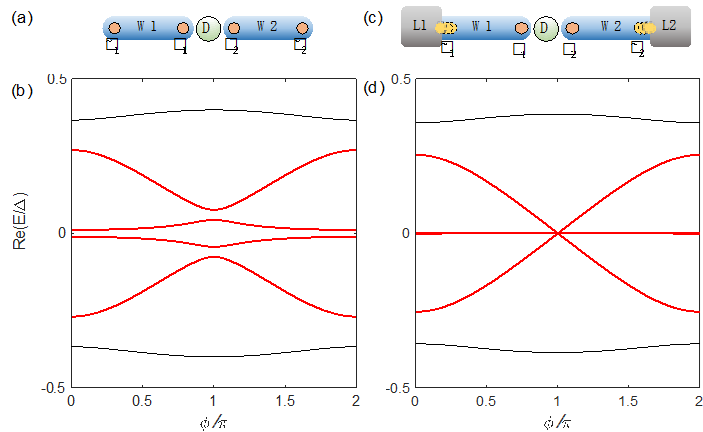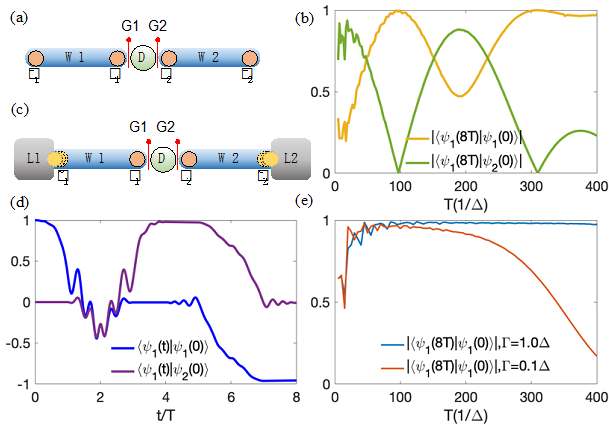Non-Hermiticity-stabilized Majorana zero modes
2022/08/24
Recently, A joint research group of Beijing Academy of Quantum Information Sciences (BAQIS) and International Center for Quantum Materials, Peking University (ICQM, PKU) has studied the stabilization effect of non-Hermitian dissipation on a one-dimensional topological superconductor (TSC). They have found that a dark Majorana mode (DMM) can be induced, which possesses the topological properties of a genuine Majorana zero mode (MZM). The work, titled "Non-Hermiticity-stabilized Majorana zero modes in semiconductor-superconductor nanowires", has been published in Physical Review B on August 12th, 2022.
As the boundary modes of TSCs, the MZMs have been drawing much attention in the filed of condensed matter because of their novel non-Abelian statistics and potential in topological quantum computation (TQC). From time to time, experiments observed possible signals of MZM, but these signals may also be caused by trivial mechanisms. For example, in a one-dimensional semiconductor-superconductor nanowire with finite length, the two genuine MZMs fuse into two eigenstates with near-zero energy (coupled MZMs), which are not appropriate for TQC. However, some previous theoretical works pointed that non-Hermitian dissipation caused by connecting the nanowire with leads can push the two coupled MZMs back to zero energy with different lifetimes.

Fig. 1. Schematic diagrams of non-Hermitian device, and transport signatures showing the coupled MZMs go back to zero energy with increasing non-Hermiticity.
In this work, the BAQIS-ICQM group has found that if the nanowire is only connected strongly to one lead, the increasing non-Hermitian dissipation can not only bring two coupled MZMs back to zero energy, but also reduce the coupling between the two genuine MZMs, thus making the two coupled MZMs polarize to two genuine MZMs. Because the other end of the nanowire is not connected to any lead, the coupled MZM polarized to this free end feels less dissipation with stronger non-Hermiticity on the connected end. This counterintuitive phenomenon leads to a DMM on the free end, which has zero energy, exponentially small dissipation and almost the same wavefunction as the genuine MZM. The DMM can simulate the topology of the genuine MZM such as 4-periodic Josephson effect and non-Abelian statistics.

Fig. 2. One of the coupled MZM feels less dissipation in stronger non-Hermiticity and becomes a DMM.

Fig. 3. Josephson effect of non-zero energy coupled MZMs and of DMMs.z

Fig. 4. Braiding results of non-zero energy coupled MZMs and of DMMs.
Before the non-Hermiticity is introduced, the coupled MZMs have non-zero energy and they have dynamic phase during time-evolution, therefore the time scale for non-Abelian braiding has to be much smaller than the ratio of reduced Planck constant and the coupling energy. Meanwhile the time scale has to be much larger than the ratio of reduced Planck constant and the topological superconducting gap to avoid the high energy states. According to the theory of this work, DMM has zero energy and its lifetime is much smaller than the coupling energy. Therefore, the upper limit of the time scale is enhanced, which is beneficial for TQC. Besides, the previously observed “quasi-MZMs” and other possible non-Hermitian mechanisms have also been discussed, which may also generate DMMs according to this work. The result of this research work shows that the DMM induced by the non-Hermitian dissipation has potential in TQC.
The first author of the work is Hongchao Liu (joint postdoctoral researcher of BAQIS and ICQM, PKU), and the corresponding author is Jie Liu (Professor of Xi’an Jiaotong University). Other coauthors include Ming Lu (Assistant Research Scientist of BAQIS), X. C. Xie (Professor of PKU) and Yijia WU (postdoctoral researcher of PKU). The work is supported by the National Natural Science Foundation of China (NSFC) and the National Basic Research Program of China (NBRPC).
Link of the publication:https://journals.aps.org/prb/abstract/10.1103/PhysRevB.106.064505
 中文
中文 Email
Email QCloud
QCloud Log in
Log in
